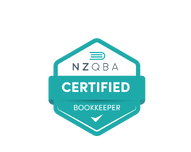Running a small business is rewarding but it’s not without its challenges. One of the biggest stressors for business owners is money. When cashflow is tight or unpredictable, it’s hard to make confident decisions.
The good news? You don’t need to be a finance expert to take control of your numbers. A few simple steps can make a big difference.
Why it Matters
According to Business.govt.nz, poor cashflow is one of the top reasons small businesses in New Zealand struggle. When you don’t have a clear picture of your finances, it’s harder to make smart decisions like when to invest, when to cut back, or even when to take a break.
5 Practical Steps to Get Clear on Your Finances
1. Track Your Income and Expenses
If you don’t know what’s coming in and going out, you’re flying blind.
How:
Use accounting software like Xero, or MYOB—these are NZ-friendly and connect to your bank account to make tracking easier.
If you’re not ready for software, start with a simple spreadsheet. List all your income (sales, services, etc.) and expenses (rent, supplies, wages, etc.) each month. We have a free template you can access here
Review your numbers weekly or fortnightly so you’re not caught off guard.
Pro Tip:
Set a recurring calendar reminder to check your finances - consistency is key.
2. Forecast Your Cashflow
Forecasting helps you plan ahead and avoid nasty surprises like a tax bill or a quiet season. Understanding the difference between making a profit and your cashflow is crucial to business success. Chantelle has even done a video explaining the difference between Profit and Loss and Cashflow.
How:
Use a dedicated cashflow software like Budgee or even a simple spreadsheet. We have a simple cashflow template you can use here:
Map out your expected income and expenses for the next 3–6 months. But even the next week or month is a great start.
Create three versions: Start with the status quo or most likely, but it is also worth taking a look at a best case (set those goals) and a worst case scenario (prepare for the what if’s).
Reminder:
Include GST, loan repayments, and seasonal slowdowns in your forecast.
3. Separate Personal and Business Finances
Mixing personal and business money makes it hard to track performance and can cause headaches at tax time.
How:
Open a separate business bank account (most NZ banks offer low-fee options for small businesses).
Use a business debit or credit card for all business purchases.
Pay yourself a regular “wage” from the business account, even if it’s small.
Bonus outcome:
This also helps you understand if your business is truly profitable.
4. Review Your Pricing
If your prices don’t reflect your costs, you could be working hard for little or no profit.
How:
List all your costs (materials, time, overheads) and make sure your pricing covers them. Depending on your business this could be done on a hourly rate, product or job basis.
Check what others in your industry are charging - are you under-pricing yourself?
Consider raising prices gradually or offering tiered options (e.g. basic vs premium service).
Key Thought:
Communicate value, not just price. Customers are often willing to pay more for reliability, quality, or great service.
5. Talk to a Professional
You don’t have to do it all alone. A good accountant or bookkeeper can help you understand your numbers and plan ahead.
How:
Ask around for recommendations or check the Chartered Accountants Australia & NZ directory.
Many offer free initial consultations—use this time to ask questions and see if they’re a good fit.
Consider working with someone who understands small businesses or your industry.
Tip:
Even a one-off session can give you clarity and confidence. You can book a meeting with the Varntige team right now
Final Thought
Getting on top of your finances doesn’t have to be overwhelming. Start small, stay consistent, and don’t be afraid to ask for help. The more you understand your numbers, the more control you’ll have over your business’s future.
Coming Up Next…
In the next post, we’ll explore how to keep your customers close—with simple ways to build loyalty and encourage repeat business.
Want the next post delivered straight to your inbox? Sign-up here.
Missed the first post in the Series - you can check it out here: Feeling the Pressure? 5 Areas to focus on to Strengthen your Small Business










